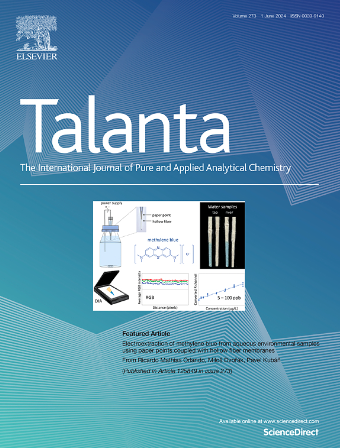双纳米酶传感器使快速家庭癌症监测
IF 6.1
1区 化学
Q1 CHEMISTRY, ANALYTICAL
引用次数: 0
摘要
早期发现癌症对于提高患者存活率至关重要,目前的体外诊断方法显示出巨大的潜力,特别是在护理点应用方面。然而,诸如耗时、高成本和对复杂设备的依赖等挑战限制了它们的广泛使用,特别是在资源有限的地区。在这里,我们开发了一种智能手机辅助的小型分析设备,解决了这些限制,为家庭快速癌症筛查提供了便携式,经济高效的解决方案。该装置采用混合纳米酶(AuNP@Cu2O-His)和双重吸收设计,使用基于适配体的识别,可以对血清中的多种癌症生物标志物进行无参比辐射定量,低至飞摩尔水平。其中,前列腺特异性抗原(PSA)的检出限(LOD)为18.75 pg/mL,甲胎蛋白(AFP)为110.31 pg/mL,癌胚抗原(CEA)为42.89 pg/mL,采用3σ/K法测定。临床样本分析证实了该设备的可靠性,结果与临床报告非常吻合(相对误差低于6%)。这些发现突出了这种强大的便携式平台在临床和资源有限的环境中用于早期癌症检测的潜力,实现了方便有效的即时诊断。本文章由计算机程序翻译,如有差异,请以英文原文为准。

Dual nanozyme sensor enables rapid at-home cancer surveillance
Early detection of cancer is critical for improving patient survival rates, and current in vitro diagnostic methods show great potential, particularly for point-of-care applications. However, challenges such as time consumption, high costs, and reliance on sophisticated equipment limit their widespread use, especially in resource-limited regions. Here, we have developed a smartphone-assisted miniaturized analytic device that addresses these limitations, offering a portable, cost-effective solution for at-home, rapid cancer screening. Employing a hybrid nanozyme (AuNP@Cu2O-His) with a dual absorption design, this device enables reference-free radiometric quantification of multiple cancer biomarkers in serum down to femtomolar levels using aptamer-based recognition. Specifically, it achieves limits of detection (LOD) of 18.75 pg/mL for prostate-specific antigen (PSA), 110.31 pg/mL for alpha-fetoprotein (AFP), and 42.89 pg/mL for carcinoembryonic antigen (CEA), as determined by the 3σ/K method. Clinical sample analysis confirms the reliability of the device, with results closely matching clinical reports (relative errors below 6%). These findings highlight the potential of this robust, portable platform for early cancer detection in both clinical and resource-limited settings, enabling convenient and effective point-of-care diagnostics.
求助全文
通过发布文献求助,成功后即可免费获取论文全文。
去求助
来源期刊

Talanta
化学-分析化学
CiteScore
12.30
自引率
4.90%
发文量
861
审稿时长
29 days
期刊介绍:
Talanta provides a forum for the publication of original research papers, short communications, and critical reviews in all branches of pure and applied analytical chemistry. Papers are evaluated based on established guidelines, including the fundamental nature of the study, scientific novelty, substantial improvement or advantage over existing technology or methods, and demonstrated analytical applicability. Original research papers on fundamental studies, and on novel sensor and instrumentation developments, are encouraged. Novel or improved applications in areas such as clinical and biological chemistry, environmental analysis, geochemistry, materials science and engineering, and analytical platforms for omics development are welcome.
Analytical performance of methods should be determined, including interference and matrix effects, and methods should be validated by comparison with a standard method, or analysis of a certified reference material. Simple spiking recoveries may not be sufficient. The developed method should especially comprise information on selectivity, sensitivity, detection limits, accuracy, and reliability. However, applying official validation or robustness studies to a routine method or technique does not necessarily constitute novelty. Proper statistical treatment of the data should be provided. Relevant literature should be cited, including related publications by the authors, and authors should discuss how their proposed methodology compares with previously reported methods.
 求助内容:
求助内容: 应助结果提醒方式:
应助结果提醒方式:


